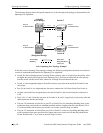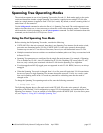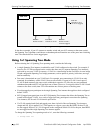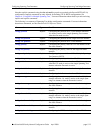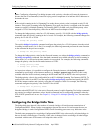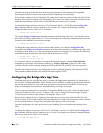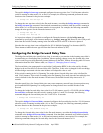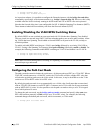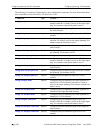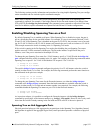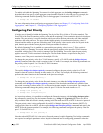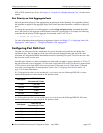
Configuring Spanning Tree Bridge Parameters Configuring Spanning Tree Parameters
page 5-16 OmniSwitch 6600 Family Network Configuration Guide April 2006
Note that lowering the hello time interval improves the robustness of the Spanning Tree algorithm.
Increasing the hello time interval lowers the overhead of Spanning Tree processing.
If the switch is running in the 1x1 Spanning Tree mode, then a hello time value is defined for each VLAN
instance. If the switch is running in the flat Spanning Tree mode, then a hello time value is defined for the
single flat mode instance. In both cases, the default hello time value used is 2 seconds.
To change the bridge hello time value for a VLAN instance, specify a VLAN ID with the bridge hello
time command when the switch is running in the 1x1 mode. For example, the following command
changes the hello time for VLAN 455 to 5 seconds:
-> bridge 455 hello time 5
The explicit bridge 1x1 hello time command configures the hello time value for a VLAN instance when
the switch is running in either mode (1x1 or flat). For example, the following command performs the same
function as the command in the previous example:
-> bridge 1x1 455 hello time 5
To change the bridge hello time value for the flat mode instance, use either the bridge hello time
command or the bridge cist hello time command. Note that both commands are available when the switch
is running in either mode (1x1 or flat) and an instance number is not required. For example, the following
commands change the hello time value for the flat mode instance to 12288:
-> bridge hello time 10
-> bridge cist hello time 10
As in previous releases, it is possible to configure the flat mode instance with the bridge hello time
command by specifying 1 as the instance number (e.g., bridge 1 hello time 5). However, this is only
available when the switch is already running in the flat mode and STP or RSTP is the active protocol.
Note that the bridge hello time is not configurable for 802.1s Multiple Spanning Tree Instances (MSTI).
These instances inherit the hello time from the flat mode instance (CIST).
Configuring the Bridge Max Age Time
The bridge max age time specifies how long, in seconds, the bridge retains Spanning Tree information it
receives from Configuration BPDU. When a bridge receives a BPDU, it updates its configuration informa-
tion and the max age timer is reset. If the max age timer expires before the next BPDU is received, the
bridge will attempt to become the root, designated bridge, or change its root port.
The max age time propagated in a root bridge Configuration BPDU is the value used by all other bridges
in the tree for their own max age time. Therefore, if this value is changed for the root bridge, all other
VLANs associated with the same instance will adopt this value as well.
If the switch is running in the 1x1 Spanning Tree mode, then a max age time value is defined for each
VLAN instance. If the switch is running in the flat Spanning Tree mode, then the max age value is defined
for the flat mode instance. In both cases, the default max age time used is 20 seconds.
Note that configuring a low max age time may cause Spanning Tree to reconfigure the topology more
often.
To change the bridge max age time value for a VLAN instance, specify a VLAN ID with the bridge max
age command when the switch is running in the 1x1 mode. For example, the following command changes
the max age time for VLAN 455 to 10 seconds:
-> bridge 455 max age 10



